Our next entry is a little closer to home, for me; maybe that's why it is my vote for the best depiction of the Vietnam War, in comics. Don Lomax grew up in Bushnell, Illinois, in West Central Illinois. Bushnell is a railroad town; literally, as it was named for a rail baron. It is a smallish community of around 3,000, with a few factories in the area. Central Illinois is a mix of agriculture and industrial, though the latter started disappearing in the mid-1070s and not much of it remains, other than agri-business and a few other specialized plants. It's located in McDonough County, in the western bulge of Illinois, where Macomb, home of Western Illinois University, is the county seat. I grew up to the southeast, near Decatur, Illinois, with a similar mix of agribusiness and manufacturing (though I grew up in a farm town, about 15 miles west of Decatur). All things considered, it's not a bad area in which to grow up; people are generally friendly and help one another out, politics tend to be more Centrist (well, used to be, anyway), crime tended more to the urban areas (that has changed to, with meth production), and you had medium to smaller schools, with more one-on-one interaction with teachers. Communities tended to support government (with a wary eye towards politicians, as a species), certainly at the civic level, honor their veterans, have community gatherings, support the local home team and carry on life at a hardworking, but quiet pace. Lomax is from a working class background and that was his world.
In 1965, Lomax was drafted into the US Army and did his basic training at Ft Knox (the part with the tanks, not the gold) and then was assigned to the 98th Light Equipment Maintenance Company, which deployed to Vietnam, in the fall of 1966, when I was born. In Oakland, they embarked on the USS General John Pope, a troopship. In a letter to The Comics Journal, published in issue #133, in response to a review of Semper Fi (and, to a lesser extent, The 'Nam) by Andy Dagilis, Lomax made mention of a incident with protestors outside the embarkation area. He is vague, but mentions a commotion and the protesters becoming agitated and the soldiers being rushed aboard, out of sight, to calm things down. He mentions signs and yelling, but also makes mention of thrown objects, suggesting possibly coke bottles or similar. In his letter, he reacts to Dagilis' comments that he interpreted as being anti-soldier, rather than anti-war. Dagilis clarified, noting a portion left out of the review, where he clarified that his objections were with Washington and not the troops sent to fight. In issue #136, Lomax offers an apology and an olive branch, suggesting they are closer on the issue than seemed before. The extremely minor exchange suggests that Lomax is a bit sensitive about how GIs were treated, when they returned from Vietnam and the stigma that followed, for some years; but, that he isn't exactly a reactionary, either. That quickly becomes apparent within Vietnam Journal, as it depicts quite a range of Vietnam experiences, with both good soldiers and leaders and bad ones, and outright psychotics. He shows drugs, prostitution, military insanity, political nonsense, support troops, aviation, special forces and also the outright horror of the war and the depravity it can build in seemingly ordinary men (and women). GIs can get out of control and they can also be extremely noble. It shows the best and the worst.
Lomax remarked of being one of three people from his class who went to Vietnam. One was a casual friend who went over as an officer and another as an enlisted soldier. One of them went to a class reunion, after getting back, a picnic, but was just recently back and didn't have much civilian clothing, so he wore his field jacket and was unshaven. No one would even look at him, let alone sit down and talk with him. Lomax chose not to attend any reunions because of that stigma. Like many vets, Lomax never fully left Vietnam behind, though in his case, he had a bit of it with him, as he and his wife were foster parents to a pair of refugee children, from the "Boat People" migration, after the fall of Saigon. He says he picked their brains as much as he could, to understand the Vietnamese to better depict them in the series and mostly learned that people anywhere in the world are pretty much the same, when you take time to talk to them. He also had two sons serving in the military, one of whom took part in Operation Just Cause, in Panama (the invasion and subsequent capture of President Manuel Noriega), as part of a Chinook helicopter squadron and another who ended up going through Ranger school and eventually Special Forces, where he served with the 1st Special Forces Group, in Afghanistan and Iraq. In both cases, the US was not actively involved in a war, when they signed up; but, both soon became involved in combat operations, a generation (or more) after Vietnam.
After returning from Vietnam, Lomax went to work for what is now the Burlington Northern Santa Fe Railroad, where he manned small stations, which allowed him to set up with his drawing board and draw comics. He started selling some in the late 70s, to magazines like Heavy Metal, Hustler Humor and CARtoons, as well as several other adult men's magazines (read: skin magazines, like Cavlier and Gent). He contributed to Pacific Comics' Twisted Tales, as well as Fantagraphics' Anything Goes. He did some work for Howard Chaykin's American Flaff, at First, as well as Starslayer, on the Black Flame back-ups. In 1987, he had done some work for the young company Apple Comics/Apple Press, started by former Comics Journal co-founder Michael Catron. With the success and popularity of Platoon and Full Metal Jacket, the pair believed that a realistic series, about the Vietnam War, could find an audience and Vietnam Journal was born.







Vietnam Journal is told through the eyes and pen of Scott "Journal" Neithammer, a veteran correspondent for a small news magazine, who is also a Korean War veteran. This status earns him a level of respect from the troops he encounters in Vietnam. What further garners their respect is his ability to just listen to them and their stories, ask questions to learn more and not pass judgement on them or what they do. They feel is trying to do his job properly, from within the units doing the dirty work, rather than at a Saigon press briefing.
The series begins in February, 1967. Scott Neithammer has stepped off a C-130 transport, at the Qui Nihon Airfield, in Bin Dinh Province. he is catching a chopper to Pleiku. He watches as rice paddies give way to the more rugged terrain of the Central Highlands, as he is briefed about procedures, by the air crew. They may draw enemy fire and may have to set down quickly, near the perimeter. He will have to move fast to exit the chopper and get within the safety of the base defensive perimeter.

Covering fire is laid down as a sergeant leads Journal into the camp. He shows him to a free bunk that belonged to a young "shavetail" lieutenant (fresh out of OCS, ROTC or the Academy), who went home in a bodybag. Journal see that his typewriter has taken a round and destroyed some of the keys. The sergeant hopes Journal is a writer of short stories. He directs him to Quartermaster Supply, where he can probably borrow a typewriter. On the way, he sees Lt Grimes hiding behind the corner of a shack, watching a Vietnamese kid, by a truck. Journal blunders into the situation and the kid runs and the lieutenant shoots him down. Journal is horrified and asks how old the kid is.
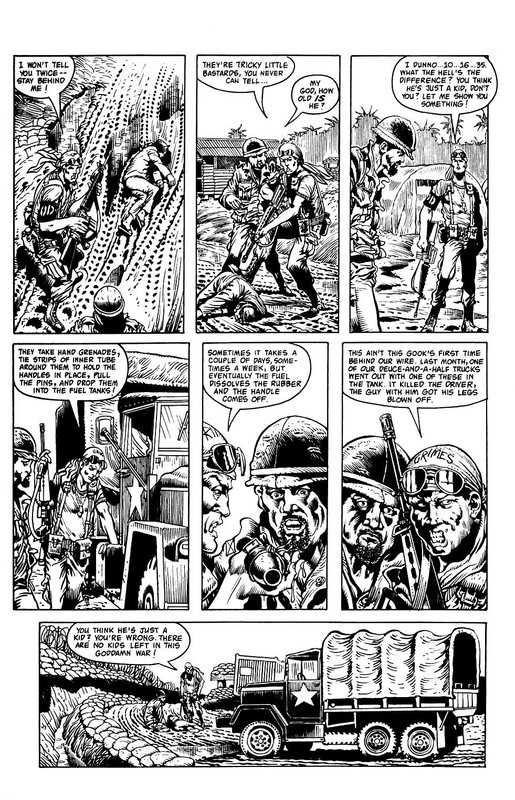
The lieutenant gives him an education in VC saboteurs, of all ages. Neithammer has been introduced to the insanity of a guerrilla war, with no front lines and an enemy that doesn't wear a uniform , often. Journal ends up sitting down to chow with them men and getting acquainted with them, as well as their dark senses of humor. The Supply Sergeant introdces himself and offers to get Journal a new field jacket to replace the battered one he is wearing. He doesn't want to part with it a tells of its journey to him, via a chain of soldiers. A staff sergeant, between tours, in Chicago, came across some protesters setting fire to a US flag. He attempted to intercede and grabs one of them by their Army field jacket and uses it to extinguish the flames. He returns to Vietnam with it, because he feels it has been soiled and needs to be cleansed, in battle (Ooooooookay.....) He ends up ina firefightand is wounded and disoriented. he accidentally shoots a mother, with a baby and uses the flack jacket to keep the baby warm and sheltered. He encounters more VC and fights them off to protect the baby. he is later found by GIs, near death and asks about the baby, who is safe. He then dies. One of the soldier takes the baby to an orphanage and starts to leave, when a woman hands him the coat. he takes it with him and wears it, in honor of the staff sergeant. One of his men, while on patrol, steps on a mine and starts to panic (delayed fuse). The soldier runs and hits him with a flying tackle, to get him out of the blast zone, saving him. he is badly wounded, but the other soldier survives. The wounded soldier gives him the field jacket.
And so it goes, as the "lucky' field jacket passes hands, until it comes to Journal. It had taken on a legend of protecting soldiers from harm and people become superstitious about it. Soldiers fight over it and get wounded, as a result. The previous owner ends up rotating home, where he encounters a protest, at the airport. When the crowd sees returning GIs, they go crazy and rush a perimeter fence and start hurling things and the returning GI is hit by a brick. Journal lends aid, until an ambulance arrives and hears the story of the jacket. The soldier gives it to him, to protect him in Vietnam, then dies.
One of the soldiers is unimpressed and points out that each owner ends up dead or maimed and Journal considers the jacket lucky, not cursed, and suggests he has it backwards. Journal decided to take the supply sergeant up on his offer, as he thinks it over.
The story introduces us to Journal, but also to combat in Vietnam, with a mixture of helicopter travel, taking fire at a base camp, patrolling the countryside, a desperate battle with the VC, rear areas, a night at a bar in a "safe" area, which is bombed, then a return to a US, with a welcome by angry and violent protesters.
The protest incident was inspired by Lomax's story of the enraged crowd, in Oakland, though in his discussion, in the Comics Journal interview, he concedes that he may have seen a few things thrown, but from a far distance. The truth of it seems to be that protesters did focus their verbal attacks on the soldiers deploying, as a symbol of the government waging the war; but it is conjecture as to whether they did anything more than yell, as Lomax and the rest were hurried away from the crowd. He uses the incident to set up Journal's meeting with a returning soldier and has him die, as a result of a protester. In the interview, he said he probably would have done the story differently, in retrospect, as he was both unfair to the protesters and it was not a particularly proud scene, for him.
Through the first story, we see how Lomax employs a grittier style, more informed by the Undergrounds and Warren black & white magazines than in the prettier mainstream comics. His work is rawer than Michael Golden's slick cartooning, but he is every bit as obsessive in the details, of ammo pouches, weapons, and linked ammunition belts for machine guns, not to mention Hueys and other vehicles. Lomax does his homework and draws things as they were. In a later story, he travels with an Air Cav helo pilot and we see the difference between a UH-1B helicopter, arrayed as a gunship (with machine guns, a 40 mmm grenade launcher and twin rocket pods) and a UH-1D "slick" or transport chopper, which can carry more troops, but only has two M-60 doorguns for defense. The same detailing is there when he is with an armored unit as it is with a later SEAL platoon, as he perfectly captures the Stoner 63 Weapon System....
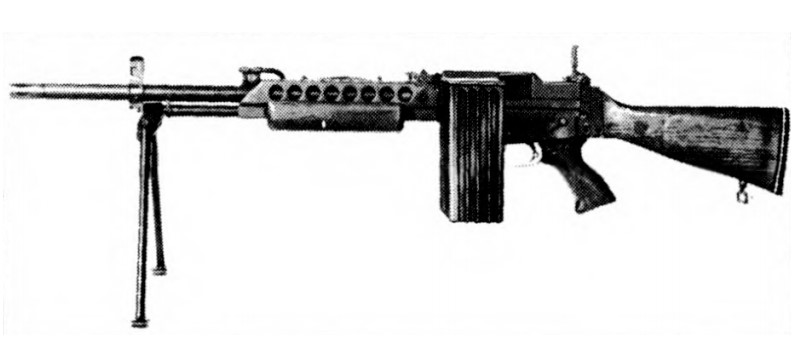
The Stoner 63 was developed by Eugene Stoner, the designer of the AR-15 rifle, known in the US military as the M-16. Stoner wanted to develop a modular weapon system, with interchangeable parts, which could be an assault rifle, a support machine gun, or a carbine, with slight modifications, using the same caliber rounds and either belt-fed or magazine fed. The Stoner 63 was the end result. It proved to be a robust weapon; but, with the political nature of US Army weapons procurement, it was rejected by the Army, due to early issues with gas pressures. The problems were worked out and the US Navy ended up purchasing a limited quantity for use by the Navy SEALs, who liked its possibilities as a support weapon, to increase their firepower, without the cumbersome weight of the M-60. SEAL platoons would carry at least one in the field to lay down covering and suppressing fire. The overall weight was not much greater than a standard assault rifle, apart from the ammo and comparable to a BAR gunner, in WW2. It used the same ammo as the M-16, which meant they avoided problems of incompatible ammunition, as with the M60 (which used a .308 cal bullet, compared to the M-16's .223 cal). Although it did not continue in service, it's use in Vietnam greatly informed the later adoption of the French Minimi M-249 as the Squad Automatic Weapon, which was also either belt fed or magazine fed, with the capability to use the standard M-16 magazines.
The first 4 issues of Vietnam Journal was collectively known as Indian Country, as they focus on infantry units, patrolling within the Central Highlands, which the troops referred to as Indian Country, as it was largely the playground of the VC. It was a central focus of pacification and search-and-destroy missions, with little long term success.
Journal starts out as a neutral observer, but one sympathetic to the GIs, as a combat veteran of Korea. He has been where they are, in a foreign land, fighting an Asian enemy, often at night, in the dark. As time moves on, he loses more and more of that detachment and becomes more directly involved in things, as circumstances require him to take a stand. Issue 2 has him go on an op with Sgt Teed and his men and he ends up helping to carry wounded soldiers to safety. They medevac the wounded and load up for dust off, when their chopper is hit and goes down. They are forced to go overland to an alternate LZ. Along the way, Journal gets separated from Sgt Teed and the rest, and finds himself lost, in the jungle. He comes across the remains of a Special Forces camp, with one survivor, after a VC attack. A wounded dog handler is the only survivor, laying there, dying, with the corpse of his dog across his lap. He tells Journal of the dog and the battle...
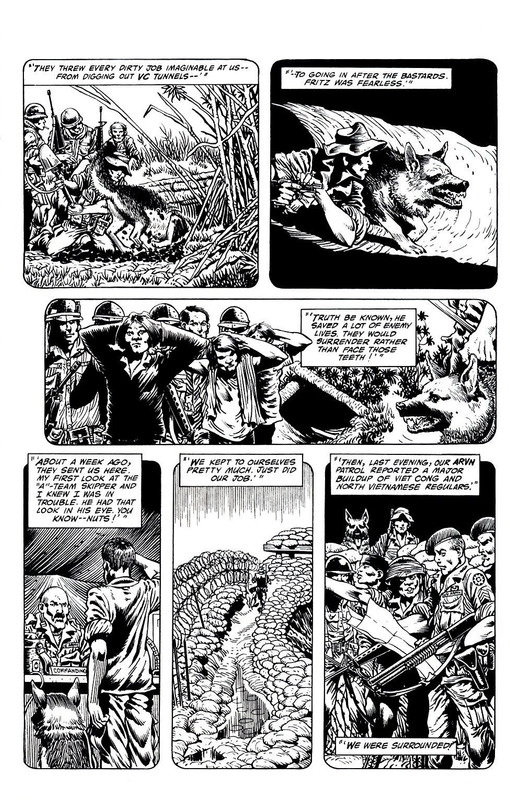
...The CO is losing his grip on reality and he doesn't include reports of increasing VC activity and imminent attack. When the attack comes, he goes into a frenzy and destroys the radio, saying they will fight to the last man.
Journal sits with him and then spots figures moving into the camp. He believes it is the VC and the soldier puts his sidearm under his jaw and shoots himself in the head. The figures turn out to be VC, but they stare at Journal and the dead soldier and move on. Journal is eventually found and returned to Sgt Teeds' unit.
Issue 3 features a bit of a look at the type of duty Lomax pulled, as Journal talks to different soldiers doing garrison and support work, like standing perimeter guard duty and emptying out latrines and burning the content. Journal asks how he feels about draft dodgers and the war....

In a nutshell, we get an average, working class view of things. Running off to Canada to avoid the war isn't something you even contemplated. You got your draft notice, you reported to the induction center and your fate was in the Army's hands, just like you had been taught. You aren't greatly aware of the wider world, because it is beyond you little part of the country.
This then segues into an illustration of the differences between Journal and another reporter, who is out to gain fame and isn't above staging footage. A lieutenant and a sergeant are in a heated argument about orders that led to men getting killed and the reporter and his cameraman are filming the whole thing, practically egging it on. When a sergeant tries to intercede and tells them to get the camera out of their faces, that three days is enough, the reporter fires back that they have permission fro general Westmoreland and the sergeant has enough and grabs the reporter, his fist cocked to punch him. He stops short of hitting the reporter; but, it pulls attention away from the sergeant and lieutenant. The sergeant holding the reporter whips his rifle around and knocks the threatening NCO out, ended the confrontation. We see that even the cameraman doesn't like the reporter.
Meanwhile, Journal talks to a soldier that drives a garbage run. He is supposed to haul it to a dump, but that route requires crossing heavily active territory. instead, he drives it to a nearby village and sells the content. Journal and his new replacement (he is rotating back to The World) accompany him on a run and sees how it goes down.
Out in the bush, the platoon encounters VC and takes incoming fire and wounded men. The sergeant calls for a medevac, but has to deal with the tv reporter and a major, looking for his chance at fame. The reporter tries to manipulate the major into using the escort gunships to engage the VC, to get better footage, telling him it will show the armchair generals, in Washington. The sergeant argues about his wounded, being loaded into the chopper and the major sends them on the way. Feinstein, the reporter, is disappointed by the lack of dead VC. They locate a tunnel and the major calls for a tunnel rat, while ignoring the gunship pilots unease about itting in the LZ, a tempting target for the VC. Everyone is playing for the camera and the sergeant has had enough....
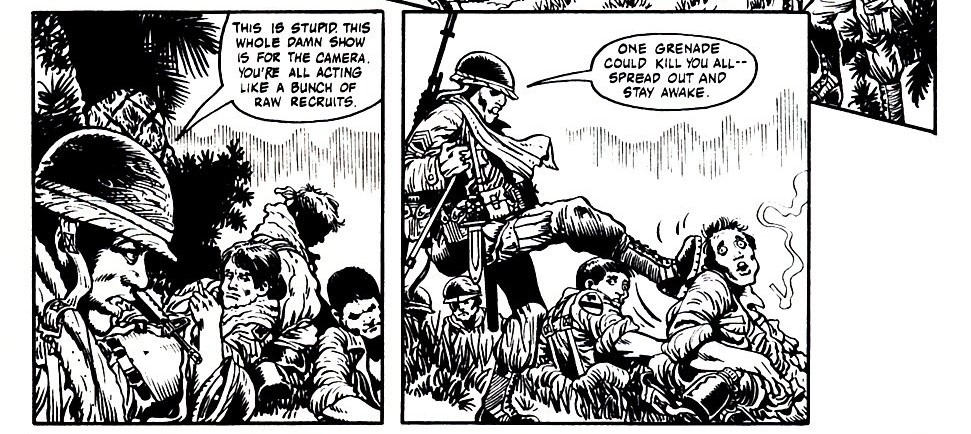
The major continues to be a hinderance, as he is under the spell of Feinstein and the camera. The tunnel rat returns and reports dead bodies left behind. feinstein wants them brought above ground to be filmed and the major goes along with it. The sergeant wonders why Charlie didn't boobytrap the complex. As men go below to drag out the bodies, an explosion goes off. The VC had wired the bodies and the camera had made everyone sloppy and they didn't check the bodies properly for boobytraps. The men react, to try to get their buddies out of the collapsed tunnel, when Feinstein shoves his camera in there and a soldier nearly takes his entrenching shovel to his skull, before he is held back.
Back at base camp, Journal sees the exhausted replacement soldier return from the garbage run. He tried to do things the right way and ends up with a flat, on the road. After he changes the tire, he finds another truck coming the other way and his rig is blocking the road. suddenly, the other truck explodes and then there are gunships, pouring on fire. After the smoke had cleared, the burning truck was still blocking the road and the soldier drops off the other driver, then brings his load back to base. Journal asks if he is going back the next day and the soldier says, "To hell with integrity, I'll take Dancer's route tomorrow and make a quick five bucks!"
Journal runs into Sgt Teed, who tells him about the film crew and Journal knows Feinstein's reputation. They met in '64, in Katanga, in the Congo, during the Congo Crisis. he caused trouble there and Journal warns him about the man. The next day, Journal accompanies Teed's men, along the Cambodian border, on a recon patrol, with Feinstein tagging along. He starts ragging about conditions and the lack of contact and he and Journal get into it...
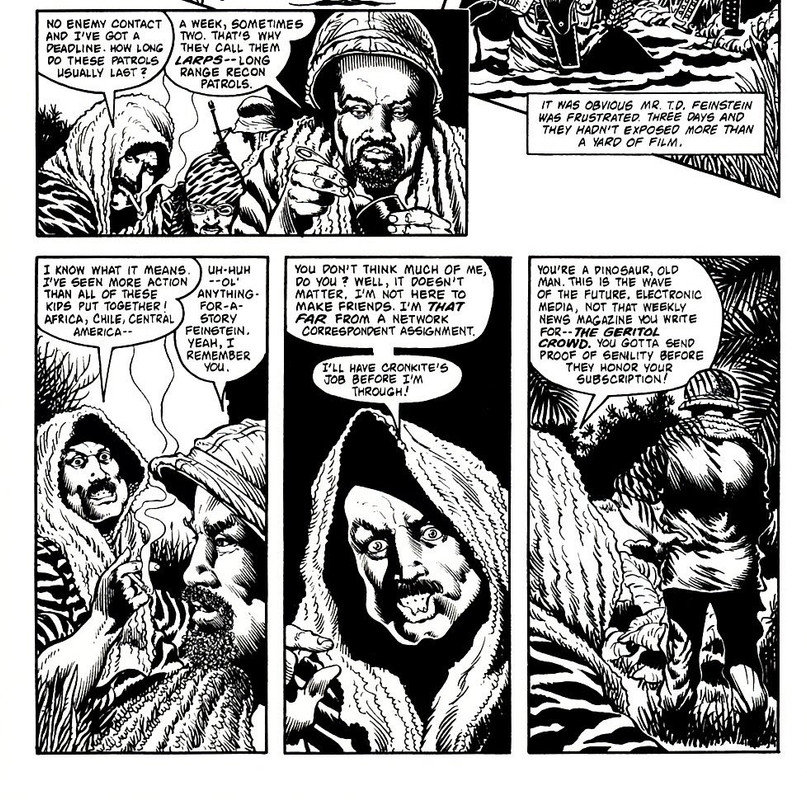
The come across a hamlet and some of Teed's men are close to the brinking point, from the long hours, lack of sleep and paranoia. Teed has to pull one soldier off of a woman he thinks might be VC. Journal notices Feinstein slipping away. As the platoon starts to argue, a hooch has caught fire. One of the men starts babbling about burning the VC out and Feinstein returns to agitate. Teed restores discipline and Journal calls out Feinstein. He plays the Westmoreland card, but Journel tells Teed that he will do some poking around, since he isn't answerable to the brass.
Journal discovers that Feinstein has been roving around, stirring up trouble with different units, to get footage. A check with Westmoreland's HQ reveals that they have never heard of Feinstein and his authorization is forged. They go to talk to the sergeant major, unaware that Feinstein has over heard. That night, he goes into the ammo dump and takes a satchel charge and plants it on a helicopter. In the morning, Journal is woken up to be told his ride is there and he dresses, grabs his gear and heads over to the pad, to find Teed and the platoon there, with Feinstein. teed insisted on him being there and reveals he knows that Feinstein was poking around the chopper. He forces Feinstein to get in and has him strapped into the seat, while Feinstein protests. he then tells Journal about the satchel charge. Journal later hears that Feinstein had been flown back to the states, with two fractured legs.
Here, we see the kinds of details that Lomax pulled, guarding bases, transporting supplies, hauling garbage, etc. Even that can get harry and a soldier will find away to avoid unnecessary danger, like selling the garbage to villagers, who have plenty of use for what Uncle Sam casually throws away. Meanwhile, he shows the difference between an honest reporter and a glory hound, out to make a reputation by manufacturing action, to get noticed. In the TCJ interview, Lomax said Feinstein was a composite of some of the bad journalists he heard about, plus how things changed in the field when cameras were there. He heard stories from the First Cav about a film crew coming along and suddenly an officer is waiting to toss a grenade into a hooch until the camera is positioned properly, instead of attending to his men and his mission. Instead, they are staging things for the cameras and Lomax extrapolated that a bit to have Feinstein trying to manufacture footage to get himself known at the networks. There is discussion about Feinstein being Jewish and the stereotype of the Jewish domination of the media; but Lomax denies that intent and brings up that Neithammer is revealed to be Jewish, in a later issue. He says some of it is his frustration with local news, where tragedy occurs and they shove a camera in people's faces to ask how they feel. Rifas asks if he has been interviewed by local media and Lomax affirms and said the experience strengthened his views about the media, at that level.
Journal then joins Teed and his men as they become part of Operation Junction City, an attempt to envelop the VC in the sector and force them into an area, with no escape, using the 173rd Airbone and 11th Armored Cavalry Regiment, as well as the 1st Infantry division and the 25th Infantry and 196th Light Infantry. Journal catches a ride with a buddy of Teed's, Warrant Officer "moonshine" McCoy, gunship pilot and aspiring hillbilly singer. Journal learns about the gunship and the variation from the other Hueys (the Slicks) and goes along for the ride. They pass over an area that looks like the surface of the moon....
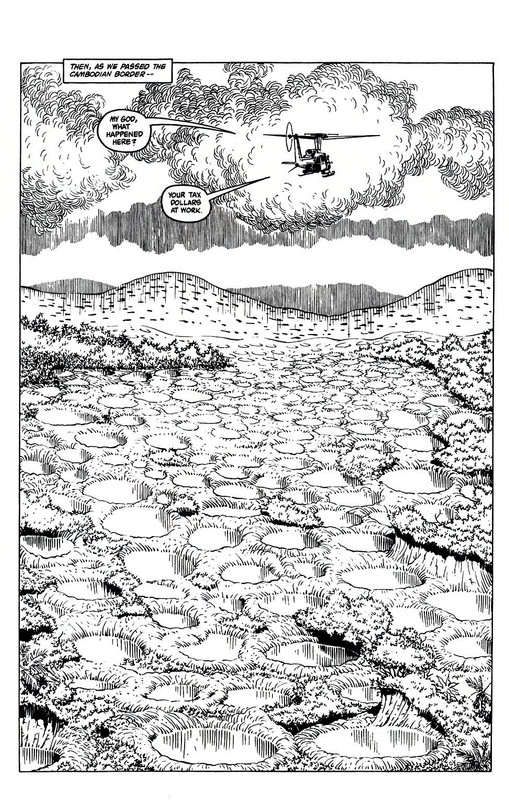
The devastation was created by an "Acrlight" mission, a B-52 strike. The area is part of the Ho Chi Minh Trail, a network of trails and roads, built by the North Vietnamese, to move men and supplies to South Vietnam. Much effort was spent trying to locate supply columns and destroy them, with LRRP teams setting up observation posts and calling in airstrikes, to massive bombardmendts by B-52s. The PAVN would just rebuild the roads with labor gangs of women, who were drafted into service to build these pathways. The crossed all over Vietnam and into Laos and Cambodia and when one part was bombed, another would be used to deliver more supplies. DOD estimates revealed that they were not even remotely effective in stopping the flow of supplies, as even their best estimates were that 10-20% would still get through, even after saturation bombing and that was enough to keep the VC cadres supplied and continue operations. They couldn't starve out the VC.
During the flight, Moonshine drops into an LZ to pick up a soldier in tiger strip camo utilities, who is on the run from the VC. Journal is introduced to Henry Rhein, a CIA operative, probably with MAC-V SOG (Military Assistance Command-Vietnam Special Operations Group). Rhein is something different than Journal has encountered. he lights up a joint as they depart. They return him to BanMe Thuot, where the 5th Special Forces Group has a field command, where Rhein is debriefed. They go for drinks, at a bar, and Journal tries to talk to Rhein,. He is from West Texas, near Odessa. he talks about a Green Beret he was talking to, outside, who made himself out to be a feared killer, but Rhein is the real deal. They are interrupted by a bar girl, wanting him to buy her "Saigon Tea" and maybe some "boom-boom," and Journal sees that Rhein is a true psychotic.
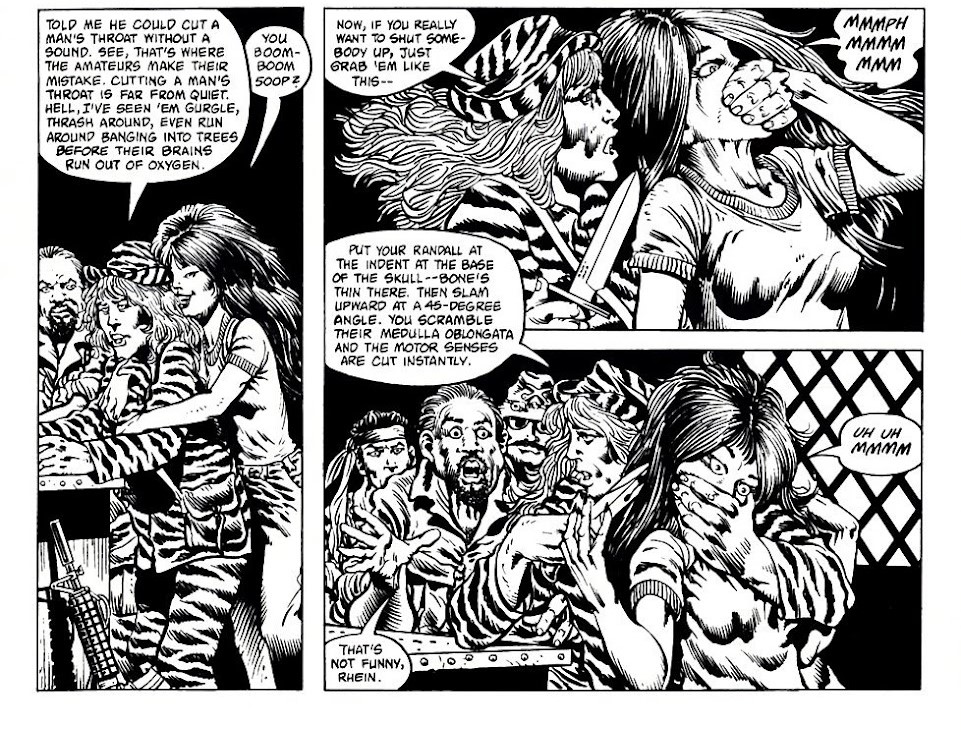
He later finds that Rhein has a bag full of human ears, trophies taken from the enemy. Journal later finds that Rhein has nearly killed the bar girl, because he couldn't perform. hey return Rhein to his operating area and take fire. They are forced to set down and call in a mayday. They get a response from call sign: Spooky, which turns out to be a Magic Dragon Gunship....
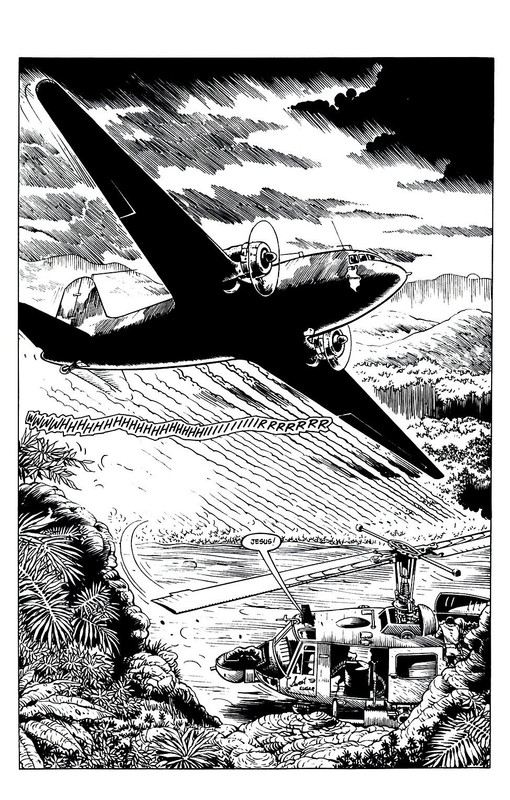
The aircraft is an AC-47 Sooky, aka Puff The Magic Dragon. It is a C-47 Skytrain cargo plane (aka a DC-3 Dakota), armed with 3 20 mm General Electric miniguns, which fire at a rate of 2-6,000 rounds per minute.
The next phase of the series, called Iron triangle, focuses on Operation Junction City, as Ted and Journal ride on the APC's of the Blackhorse Regiment, the 11th Armored Cavalry Regiment. They operated with tanks and APCs, t to provide the "hammer" that would strike the anvil and destroy the VC in the Iron Triangle. During the Tet Offensive, the unit was instrumental in smashing the PAVN and VC attack, in Bin Hoa and forcing their retreat. Science Fiction author David Drake served with the unit, in Vietnam, and based his own "Hammer's Slammers" on the unit.
Journal also gets a ride in a LOACH, a Light Observation Helicopter, the Hughes OH-6A Cayuse. It's distinctive curved canopy made it ideal for observation, as it gave a greater field of vision. The aircraft is still in use in several police department highway patrols. In Vietnam, they were used to direct artillery fire and to scout ahead, often acting as a decoy to draw enemy fire, which would then be hit by gunships or "fast movers." (fighter-bombers).

I can go on, but will curtail plot synopses here. During this flight, Journal is forced to make a decision and mans an M-60 to return enemy fire. he stopped being an observer and became a participant.
During the Battl of the Ia Drang Valley, in 1965, journalist Joseoph Galloway accompanied the First Cav and witnessed the intense battle on the ground, which at one stage reached hand-to-hand combat. Galloway stopped being an observer when he assisted in evacuating wounded, while under VC and PAVN fire.
I have not read any statements from Loma that Galloway inspired Neithammer, but he certainly shares attributes with him. Galloway served in the US Army, in WW2 and attended college on the GI Bill. He became a correspondent and bureau chief, before joining the First Cav, in Vietnam. For his actions, he was awarded a Bronze Star with V For Valor device, signifying action under enemy fire. He later collaborated with Lt Col Harold G Moore on the book We Were Soldiers Once...And Young, a detailed account of the battle, later turned into the film, with Mel Gison and Sam Elliot.
Neithammer gets further involved in trying to rescue some villagers, caught between them and the VC. He and Teed find themselves in a major fight, near a buddhist temple and Teed is killed, protecting Journal. Journel aids in the fight, detonating a claymore mine and in killing a VC, with an entrenching shovel. He survives, but is in a state of shock, muttering about Pusan, in Korea.
Journal is medevaced and witnesses a medic in action, as he fights to keep guys alive on the trip to a hospital, ignoring his own burnt hands. We also see Teeds men, without his calming influence, get more violent, as Sgt Wade gets more and more brutal and the rest follow. They eventually catch a truck ride back to base, and start messing around, throwing spent jerry cans at Vietnamese peasants, on the rod. Then, they start tossing ones with fuel and shooting them, in the air, igniting the fuel and they kill an old woman. Journal ends up recuperating, in Saigon, at a hospital and Lomax depicts a buddhist monk, setting fire to himself. later, Journal hears that Gen Westmoreland will be visiting wounded, awarding them their purple hearts. He notices a soldier messing with his .45. The next day, Westmoreland arrives and awards the specialist his Purple Heart. Journal distracts the setting by asking Westmoreland about his disagreements with Washington, in the execution of the war and Westmoreland and his aid decide that he is needed elsewhere. the specialist goes for his pistol and Westmoreland turns to leave and Journal hits him over the head with a beadpan, and says the mostquitos are bad here. Throughout, Journal is troubled by visions of the dead, as well as Henry Rhein, saying he is just like him.
Journal heads home and has a layover and sits in an airport bar, where a drunken woman decides to start something and calls a wheelchair-bound and amputee Green Beret soldier a babykiller, then throws her drink in his face. She is dragged away and Journal helps the soldier. They talk about his injuries and he tells the story of how it happened. It wasn't exactly in battle, as he was attending to a still, below a hooch, when the VC attacked the camp and a mortar round landed next to it and the still exploded. They land in Honolulu and colelct their bags and we see protesters. One starts asking the sergeant how it feels to be maimed, for LBJ and he calls him an a-hole, which sets off the protester and the rest and they start jostling the wheelchair, until the sergeant is knocked over. The protester is stunned by what he has done and the sergeant gets himself back in his chair, resets his beret on his head and says he will be fine. One of the women agrees.....

Here, we see the difference between Doug Murray's approach and lingering resentment and Don Lomax's more nuanced stories. In his interview, he said the US should have pulled out of Vietnam in 1962 and saved themselves from the mess. He came out of the war without injuries and without the PTSD that others experienced, but still found that people treated him like a pariah. He worked for the railroad and drew comics. He seems to have a calmer perspective on things, while Murray, a combat soldier, still has resentments. Lomax filters a humanity in his work that goes beyond just telling the soldier's side of things. He treats the Vietnamese as people, he walks back the earlier depiction of protesters to show that some just got caught up in the moment, but their battle was with Washington and not the soldiers. here, he can give one character a welcome home he never got It reminds me of a story I viewed from a vet, who served in Vietnam and in the Iraq, as a reservist....
Lomax was able to change a little history, to give a welcome that should have happened 20 years before. The issue was published in 1989. Two years later, America would fight a war against Iraq, to liberate Kuwait and secure the oil fields that were vital to the US economy. Troops were first deployed for Operation Desert Shield, a massive buildup of forces, in bases in Saudi Arabia, pointed at the Iraqi border, while diplomatic channels are pursued, in the hopes that facing the combined power of the Coalition nations (including the US and the UK) would get Saddam Hussein to think twice and withdraw. However, Hussein needed to look strong at home and did not, leading to first a massive aerial bombing and cruise missile attack campaign, which was then followed by a ground attack. Unlike Vietnam, the war was over quickly, though Saddam was left in power, setting the stage for a decade later, when the 9/11 attacks were used as justification for attacking Iraq, with talk of evidence of weapons of mass destruction, which were never produced. After the fighting was over, units started returning home. This time, Amercians were determined to welcome them, like they should have done, with the returning Vietnam veterans.
Anthony Swofford, in his memoir, jarhead, wrote of his return home, riding on a bus, passing by cheering citizens, welcoming home. A Vietnam vet hops on and welcomes them back, but is also overcome by the moment, as he experiences what he was denied.
When I was serving in Charleston, during the build up, I started seeing the signs of "We Support Our Troops." I kind of had a cynical mindset about it, especially when I saw it displayed at a used car dealership that was notorious for fleecing sailors with high interest auto loans, drawing them deeply in debt and using the military system against them to get the command to force the sailor into a debt repayment schedule, at lower payments, but longer terms, until the sailor couldn't pay and they repossessed the car. Then, they'd repeat the process. I use to give talks to new sailors about these places and to avoid them, about how to protect their money and use savings allotments to put away money and not be tempted to spend it all on payday, because they had cash in hand. To me, some of the support was just lip service from people from parasites who preyed on the military. However, when you saw the celebrations for people returning, it made you feel glad that enough were sincere about welcoming people home. My only wish is that they would continue that support afterwards, by lobbying their congress persons to ensure that the VA has the proper funding and resources to treat the scars of their service, physical and mental, especially as Gulf War Syndrome began to appear.
In the next part of the series, Journal returns to Vietnam, after healing up and travels with the Brown Water Navy, the riverine units that patrolled the Mekong River and operated in and around the Delta, which was a major supply route for the VC. We see him with swift boat units, as they patrol and stop and search sampans, carrying families and goods up and down the river. Quite often, those families hid weapons. We see the base ships and barges that act as home for these units, when not on patrol. Then, Journal moves out with a SEAL platoon, in the Plane of Reeds, traveling via a hovercraft. Lomax illustrates the aforementioned Stoner 63, as well as combat shotguns and the Mark 22 pistol, aka the "Hush Puppy." it was a Smith and Wesson Model 39 9mm auto pistol, with a modified barred that was threaded to accept a noise suppressor (a silencer, to spy film fans), used to eliminate sentries and guard dogs. We also see the armored hovercrafts, which transport the team into their operating area. Lomax had mostly depicted infantry and helicopter missions, though we saw the odd Green Beret and black ops operators, like Henry Rhein. Now, we saw special operations soldiers in the field, especially one, that at that point, was relatively unknown, unless you count that bull@#$% movie, with Charlie Sheen.
During the storyline, Journal plays chess and talks with an ARVN Ranger and they discuss the rather poor performance of the regular ARVN units and the ranger makes a point about how US advisors treated the Vietnamese they were supposed to be helping.
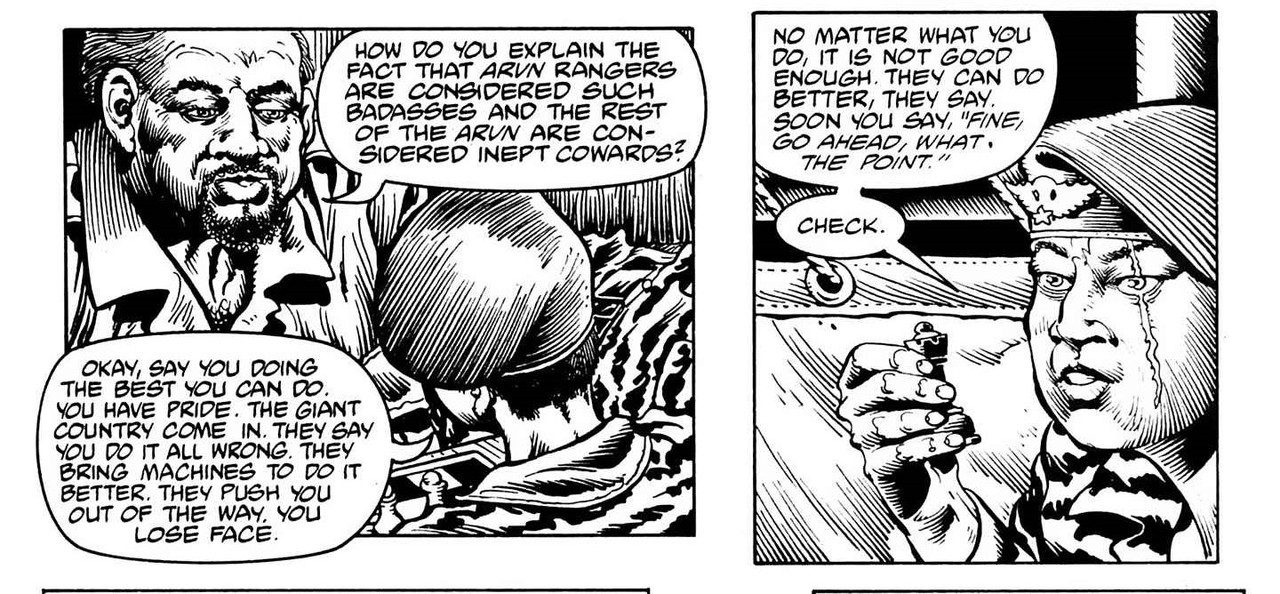
They meet up with a local contact, who turns out to be Henry Rhein, who is leading a Provincial Reconnaissance Unit (PRU) and has information about American POWs being held in a village. Their mission is to hit the village, with the PRU providing security and extract the prisoners. It turns out to be a bluff, as what Rhein is really after is heroin. It's all part of CIA drug smuggling operations, in conjunction with ARVN officers, which then fund CIA operations in the region.
The PRUs were a CIA program, to create counter-guerrillas, to fight the VC and target their leadership, as an extension of the Phoenix Program, a CIA operation to capture or assassinate VC leadership. In practice, more often than not, suspected VC leaders were minor players or innocent victims, who were murdered and tortured, before the media got hold of the story and exposed the operations, leading to Congressional inquiries.
Lomax has a major issue with the CIA and speaks of seeing shadowy people in bars and military areas, who most identified as "spooks," or CIA officers. The CIA was deeply involved in psychological warfare, covert reconnaissance, running agents among the VC and all kinds of little games. Special Operations Group was pretty much run by them, in conjunction with the Phoenix Program and Operation Shining Brass, a program which inserted deep penetration recon teams into Laos and Cambodia, to track VC an PAVN movements and pass along the intel, for airstrikes and ambushes back across the border (and even covert strikes in those nations). More on this, in a moment.
Journal moves on to Dak To, where the 173rd Airborne are operating and finds himself with Vietnamese peasants, on the run from the VC. He makes it to safety and ends up in the fighting to defend a Special forces camp. We also see an Australian unit in this segment of stories.
By this point, the regular series ends, as Lomax switches to a series of mini-series, detailing specific parts of the war, rather than roving between units. First, he covers the Tet Offensive, across 6 issues.

This is followed by the Siege of Khe Sanh, detailing the attacks on the Marine base, by VC and PAVN, during Tet.

That is followed by 4 issues of High Shining Brass.

This mini explores the experiences of Robert "Bob" Durand, an infantry soldier who enlisted and went through Ranger school and, later, Special Forces training and finds himself recruited by the CIA to lead a Shining Brass recon team, composed of himself and two other Americans and Chinese Nung tribesmen, who are inserted in Laos, to track enemy movements. Along the way, he encounters shady colonels who don't seem to exist to anyone else, betrayal, death, and violent episodes. We see CIA helicopter crews who ferry them in and out and who also have a secret base along the Chinese border, hidden in the side of a mountain, like in a Bond film. Durand is given experimental drugs to increase his night vision, which cause psychotic behavior, when mixed with alcohol.
This is where my BS Meter started tripping. Lomax reiterated the Chinese bases in his Journal interview and other things about the CIA that sound like conspiracy theory nonsense. With the CIA, truth is often stranger than fiction. Still, the base hidden behind a camouflaged door, in a mountainside is just too much...at least, the way he depits iut, with the helo flying into the opening and the door swinging shut. It's like something out of Jonny Quest. You expect to see a guy with a white cat to greet them.
I'd be more willing to buy a remote base, hidden in a cave complex, or something like that, with aerial resupply, like the Chindits and OSS units, in Burma, in WW2. I have trouble with a major operational and high tech base. Also, Durand sounds more than a bit delusional and we only have his word for things.
Regardless of the truth, it makes for a great comic. Durand was a real person and actual Special forces, serving with the 5th Special Forces Group and SOG. He took his own life in 2003 and is said to have suffered from PTSD, from questionable internet sources. Not much else appears out there, aside from references to the comic.
Lomax also created the 9 issue Desert Storm Journal, where Neithammer is embedded with US troops, during Operations Desert Shield and Desert Storm.
Lomax gives the greatest scope to the Vietnam War in comics, while giving us a soldier's perspective, but with elements of the Vietnamese and others. Vietnamese dialogue is all presented in the Vietnamese language. Lomax would write it and it would be translated and lettered into the story. We get no English translations, since most soldiers had no clue what the Vietnamese were saying, other than a few words and phrases.
Another key element in the series is the use of the POW/MIA flag and a page given over to highlighting a servicemember listed as Missing In Action, during the Vietnam War. Lomax says he included it to highlight the issue. Some 2000= servicemembers were listed as Missing In Action and their families were left in limbo, for decades. Eventually, most were listed as Missing, Presumed Dead; but, the ambiguity drives many of those families and veterans for an accounting of what happened to them, with conspiracy theories of Americans still being held as POWs. There is some historical basis for this, as the Viet Minh did not immediately release all French prisoners, after the armistice. Further evidence is from testimony of hundreds, if not thousands of Vietnamese, claiming to have seen Americans being held by the Vietnamese. However, no evidence has ever been produced to verify such statements and efforts to locate missing Americans have turned up only a relatively small number of human remains. The reality was that many went missing in combat actions or went down in remote areas and are most ikely dead, but there remains were never recovered. the chances of finding anything are practically nil, given the nature of the Vietnamese jungle and mountain regions. Most likely, any evidence has been claimed by the jungle. Still, the need to know drives things. Lomax doubted all of them were prisoners; but, he felt that if even 1% were, than it was worth searching and this was the best way he could help.
The search for MIAs has driven fiction plots and movies, such as the action film Uncommon Valor, with Gene Hackman and Patrick Swayze, as well as the lesser Cannon film efforts, with the Missing In Action series, starring Chuck Norris, in all his wooden glory. Those films are an insult to everyone's intelligence and the craft of filmmaking, though Rambo wasn't much of a step up, except for budget and the performances of Charles napier, Richard Crenna, and Steven Berkoff. The exploding arrows were cool, though.
If I were to recommend only one series about the Vietnam War, it would be Vietnam Journal. Lomax fills it with well developed characters, an attention to detail, humor, horror, irony and everything that makes a great story, fiction or otherwise. It isn't without faults in the depiction of the actual war, but it registers with a better authenticity than Platoon and without the restrictions and editorial pressure of The 'Nam. Lomax's grittier style brings home the horrific parts of the war and also lends an expressive nature to the characters. Some bodytypes seem a bit odd, as a few guys are depicted as double chinned and paunchy; but, I can see that in rear areas, more than the combat locations Lomax depicts. It adds a variety to see something other than All-American hero types in the stories. The series is not without war comics cliches; but, it handles them on a more adult level.
The individual issues may be hard to find; but, the book collections, from Transfuzion (Gary Reed's former Caliber company) can be had, on Amazon and there are digital sources out there, including the first volume of the series, Indian Country, from the Byron Preiss collection, which included further material about Neithammer's experiences in Korea and some other short segments. The Trasfuzion editions have a couple of collating mistakes in one or two of them, based on my copies. Lomax started a website to continue the series, after taking a course in basic web design, some years back. When I attempted to access it, via the wikipedia link, it was blocked by my Norton application. Lomax's Twitter page hasn't had postings in two years. Lomax is 79 and may have curtailed his work.
Next, a couple of side comics related to Vietnam, though more as background detail, before moving to the final phase, with more recent Vietnam stories. I will look, briefly (I promise) at Cinder & Ash and Mike Grell's Jon Sable "MIA" issues.



